Tibes Indigenous Ceremonial Center
In 1975, hurricane Eloisa passed near Puerto Rico with torrential rains that caused massive flooding. Don Luis Hernandez, a sugar cane worker and farmer from the Toma Vieja section of Tibes in Ponce, made charcoal as a part-time job. While searching for wood to make for charcoal, he discovered remnants of indigenous cultures that had been buried over time and were uncovered by the flooding.As he walked through Vega de Tani he saw shells and pieces of «bricks» which prompted him to explore further. He found pieces of bone and shells and ceramic fragments. He felt he had discovered a great secret and he initially kept it to himself. Although he realized that the objects he had discovered belonged to Puerto Rico’s Indian past, he never realized that he had discovered one of the most important archeological sites in the Antilles.One day in 1976, while exploring archeological sites on the island, the Archeological Society of the Southwest arrived in the area of Tibes. While asking questions, they learned of Don Luis’ discovery and he took them to Vega de Tani. In surveying the area. they realized it was an archeological site with a ball field and a large rectangular area, which turned out to be a large plaza.Some months later, in a meeting of the Guaynia Society of Archeology and History at the Catholic University of Puerto Rico, members of the Archeological Society of the Southwest announced the discovery of a «very good» archeological site, including ball fields, in Ponce. Both groups made plans for further exploration.When the Guaynia Society arrived at the site, they realized its immense magnitude. It was protected by dense overgrowth and bordered the Portuguese River (in pre-Columbian times called the Baramaya River) making access difficult.Little by little the Vega de Tani began to reveal its secrets, for the benefit of Puerto Ricans and the scientific community, producing the most important archeological site of its type in the Caribbean.
They discovered the oldest Antillian Indian ceremonial complex yet uncovered in Puerto Rico, consisting of nine ball courts and three ceremonial plazas. Within its boundaries is the largest indigenous cemetery yet discovered – consisting of 186 human skeletons, most from the Igneri and the rest from the Pre-Taino Cultures.In its beginnings, the Tibes Indigenous Ceremonial Center was inhabited by Indians of the Igneri Culture, who made ceramics dominated by the Hacienda Grande and Cuevas styles (which appeared on the island around 25 AD+/- and remained until 600 AD+/-, according to Rouse, 1982) when the site was abandoned, perhaps because of some natural disaster (Questell, 1978).It was replaced by the Pre-Taina Culture which populated the Island during a rapid period of population growth. It was this Indian group that began the stone structures which make up the Ceremonial Complex of Tibes. Evidence points to the stone ball court called «The Chief’s Ball Field,» on the north side of the area, as the earliest structure. Other structures are contiguous, including a unique structure called the Star Plaza because of its shape.Around 1,000 A.D. the Tainos appeared, repopulating an abandoned Tibes. Some archeologists think that later generations of Taino peoples, whose origins in Tibes are demonstrated by the construction of the ball courts and plazas, later constructed the Caguanas Indigenous Ceremonial Center for political/economic/religious reasons. (Oliver, 1991)At Tibe’s discovery, the Guaynia Archeological and Historical Society took charge of the field archeology work, including the restoration of the stone structures. At various times, they were assisted by well known Antillian archeologist including Richard Alegria, Irving Rouse, Marcio Velez Maggiolo, Victor Carbone, Plinio Pina Peña, Carlos Alberto Martin, Mario Sanoja, Fernando Luna Calderon, Renatto Rimoli, Ovidio Davila among others.Juan González Colón (principal investigator), Pedro Alvarado Zayas, Jesús Figueroa Lugo, Luis A. Rodriguez Gracia (archeological photographer), Miguel Rivera Puig (photographer) and Edgardo Maíz participated in the excavations. A group of archeological technicians provided unending assistance.There have been many findings of significant archeological impact at Tibes, resulting in the revision of Antillian archeology. The twelve stone structures, including ceremonial plazas and ball courts (nine of which are open to the public today), demonstrate that the ball courts and plazas in the Antilles are much older than originally thought.The Indians that inhabited Tibes, as an agricultural/ceramic society, needed to know the seasons by observing the stars and their movements in order to properly cultivate the crops on which their survival depended. As a result of archeological-astronomical investigations conducted by Archeologist Osvaldo García Goyco, «there is evidence that some of the plazas are orientated in relation to the equinox and solstice of the four seasons of the year»… «this makes the Tibes Indigenous Ceremonial Center the oldest astronomical observatory in the Antilles» (García Goyco).The finding of courts for ball playing indicates that this custom is much older in Puerto Rico than was originally thought and that the Indians excavated and leveled a large quantity of earth in order to construct these ball courts and plazas. In addition, it represents the magical-religious tradition of their ancestors, since the principal plaza was built over a cemetery.It also shows that, in Pre-Taino times, the indigenous society was very well organized with a stratified social structure. To construct the variety of stone structures required an ability to carefully plan, mobilize, direct and maintain many workers. They transported tons of rock from both the nearby Baramaya River and from distant places to complete the structures.In addition, the excavations have provided important information in respect to the inhabitants stone and shell carving, ceremonies, eating habits, ceramic styles, etc.In ceramic styles, there is information on the «Cuevas» style of the Igneri Culture and its possible evolution into the «Elenoide» style of the pre-Taino Culture. (Pedro Alvarado Zayas, thesis, 1981)In the area of physical anthropology, there are sufficient human remains (186) to give important information on demographics, eating habits, illnesses and mortality indices, among others. It may also provide DNA information that could resolve the question as to where these people came from originally.Among the structures of great importance are the ball courts, of which nine have been restored. They are:
Ball Court # 1
-
- Un-named, it is the most southerly of the structures. Rectangular, with open ends, its sides are formed by two rows of stones in an east-west orientation. It measures 12.8 meters long, by 10.9 meters wide. It was constructed by the pre-Taino culture.
Ball Court # 2
-
- Called the «Horseshoe Ball Court» because of its shape, its «U» is orientated east-west with an open end. On the north and east, it has stone walks. On the south side, it has a row of stones that increase in size from east to west. It measures 35.1 meters long by 9.3 wide and was constructed by the pre-Tainos.
Ball Court # 3
-
- Called the «Cemi Ball Court,» it was built with a north- south orientation paralleling the Baramaya River. Originally, the western side extended to the river’s bank. During archeological excavations, they found eleven burial sites with offerings associated with the first phase of Tibes’s occupation: «Hacienda Grande» y «Cuevas» style ceramics. It is the largest ball court in Tibes, measuring 76 meters long by 15.15 wide. It is «U» shaped and was constructed by the pre-Tainos.
Ball Court # 4
-
- Called the «Santa Elena Ball Court,» it is formed by two parallel rows of stones. It is oriented east-west, with two sides open, and measures 14 meters long by 8.4 wide.
Ball Court # 5
-
- Called «One Row Ball Court,» it is oriented north-south and consists of a single row of stones with a depression forming the remainder of the ball court. Three sides are open and it measures 13 meters long by 10.3 wide.
Principal Plaza # 6
-
- It is orientated north-south. The north and south sides are formed by stone rows; the east-west by two walks. It has a single monolith in the center which was possibly used in magical-religious ceremonies. An infant was found buried below it, which may suggest a funeral ritual. It measures 39.6 meters long by 36.6 wide.
Oval or Elliptical Plaza #7
-
- This is the most recent structure in the Ceremonial Complex of Tibes and is composed of 6 triangular stone platforms. According to one archeologist, «the eclipse consisted of 8 triangles, separated into three sections by three entrances» (Gonzalez, 1987). It measures 30 meters long by 25 wide. It is orientated north-south.
Ball Court # 8
-
- Called the «Bat (as in the flying mammal) Ball Court,» Rectangular with open ends oriented in an east-west direction, it consists of a stone walk on the north and a stone row on the south, measuring 17.5 meters long and 11.9 wide.
Ball Court # 9
- named the «Chief Ball Court», it is rectangular and is located at the north of the complex running north-south. It has two parallel rows of stones and open ends. It is the oldest ball court at Tibes and measures 15.2 meters long by 10.4 wide
The stone structures of the Tibes Ceremonial Center were used by the pre-Tainos, for two possible purposes:
- The plazas were used to celebrate ceremonies of great importance, where a large number of people could congregate.
The ball courts were used to play ball. This does not mean that the plazas were not also used for ball playing. According to Fray Bartolome de las Casas, the ball game was played in the following manner:«One team served the ball and the other team returned it, using anything but the hands. If the ball arrived at shoulder height, it was returned like lightening. When it came in near the ground, the player rapidly hit the ground, striking the ball with his buttocks. Play continued from side to side until an error was made.»
The ball game was played for a variety of reasons: sport, diversion, magical-religious ceremonies where they bet – from fruits to ritual compensation. An example of this was seen during the revolt of the Indians in 1511, when the Indians captured a young Christian and decided his fate by way of a ball game:«A chief called Aimanio took a young Christian man, son of one Pedro Xuarez de la Camara, native of Medina del Campo, tied him up and ordered the people to play ball (the ball game of the Indians) with the winners having the right to kill the young man.» (Oviedo)
The indigenous used the plazas and ball courts for other activities, such as simulated fights. This was for the men and simulated a battle or war. It was conducted when one group visited another and required a lot of people and large spaces like the plazas. Pedro Martir de Ángleria writes that, in the Jaragua region of Haiti, they gave Don Bartolome Colon a reception in which, after dancing and singing, they conducted a great fight, to the delight of the guests. They described the event as follows:«… fighting man to man like enemies, they clashed in defense of their possessions, . . .and so these squadrons joined in combat with bows and arrows. Four men died in the space of one hour and many others were injured; and even though they had fought with utmost strength, without a signal from the Chief given at our request, the contest did not end» (Angleria)Besides these activities, they celebrated «areytos,» celebrations of music, dancing, singing and ceremony, which served as an oral history. It was celebrated often, sometimes with only men, or only women, or both together. They danced the «areyto» for many hours until they were exhausted. Fray Bartolome de las Casas writes:«And on this island what I could understand was that their songs which they call ‘areytos,’ were their history passed from person to person, fathers to sons from the present to the future, as here uniting many Indians… passing three or four hours or more until the teacher or guide of the dance finished the history, and sometimes they went from one day to the next.»(Las Casas)
During the process of excavation and restoration, Guastella Films was commissioned by General Foods to make a documentary on the indigenous theme, «Herencia Taina» (The Taino Inheritance), a large part filmed in Tibes. An Indian village (Yucayeque) was constructed, according to the description of Gonzalo Fernandez de Oviedo, and it remains as an attraction today.According to the accounts of Fray Ramon Pane, the Yucayeque consisted of a «caney» or rectangular house used by the Chief. There, they stored the main cemi of the tribe. It was on the edge of the village near the ball court. The other «bohios» or common persons’ houses, were round or oval, large or small, for one family or many. When the Chief or someone important like the head of a family died, they burned their house for religious or hygienic reasons.According to the chroniclers the settlement pattern was as follows: the houses were arranged around the plaza or ball court with the «caney» at the end.«… in front of the Chief’s house was a large rectangular plaza flat and well swept, which was called in the language of these islands, batey…»(Las Casas)The Tibes Indigenous Ceremonial Center opened its doors in 1982, for the benefit of all Puerto Ricans and tourists who desire an encounter with the past.The material recovered from the archeological excavations is stored in a laboratory at the Tibes Indigenous Ceremonial Center where the second phase of the investigation, the laboratory analysis, will be conducted. This analysis will provide data about demography, alimentation, diseases, life spans, DNA, etc.In addition, they will gather information about stone and shell skills. The most important part of Tibes is its magical-religious nature: the ball courts, petroglyphs, amulets, cemis and evidence related to burials which provide information about their belief in an after-life.They will conduct studies on the prehistoric fauna and flora, now extinct. They will also study the construction of the ball courts and the plazas, their age and possible relation to other areas in Puerto Rico and the Antilles.Tibes, by its very nature, is a center for scientific-historical investigations. Plans are underway to develop it as an archeological investigation center for Puerto Rico and the Caribbean, using the latest in technology and an extensive specialized library to form a computerized informational network for use by archeologist and investigators in Puerto Rico and beyond.They hope to begin publishing archeological and historical material to benefit both the scientific community and the general public.At the present time, the Tibes Indigenous Ceremonial Center has the greatest number of visitors, for a site of its type, in Puerto Rico and the Antilles – more than 80,000 a year. Many of these visitors are students, which furthers their mission of educating new generations of Puerto Ricans about their roots and indigenous heritage.The Tibes Indigenous Ceremonial Center, is the heritage of all Puerto Ricans «here lived our indigenous ancestors, here are our roots; it is the legacy which we received from our ancestors – our inheritance».
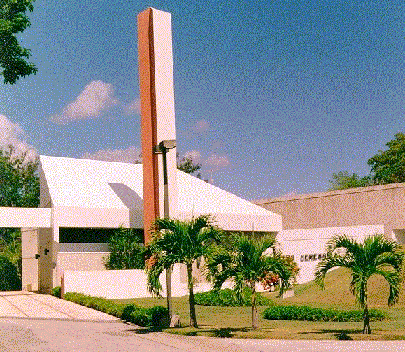
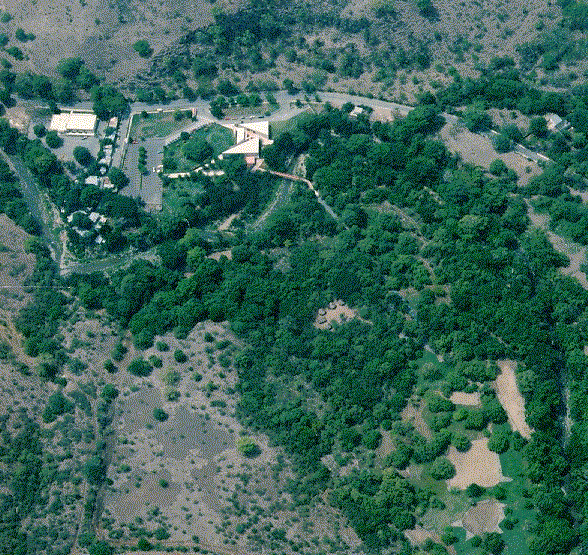
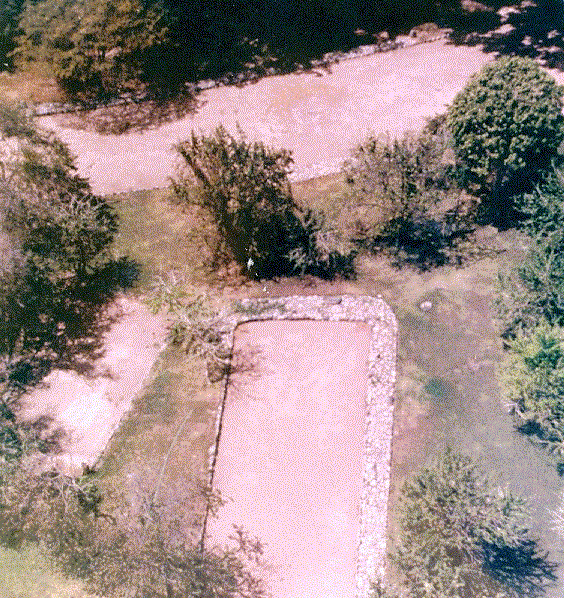
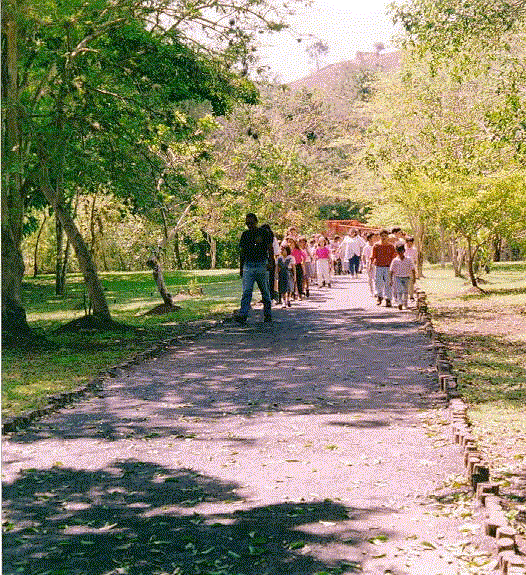
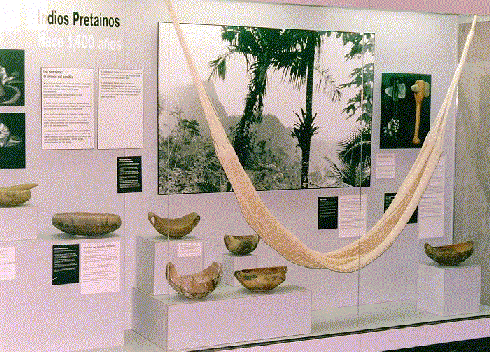
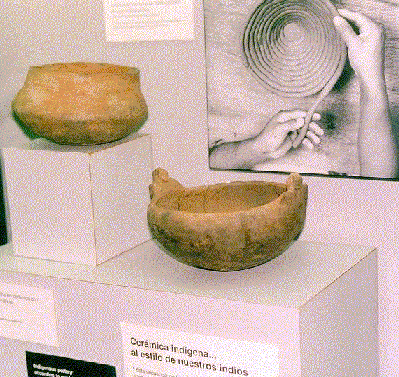
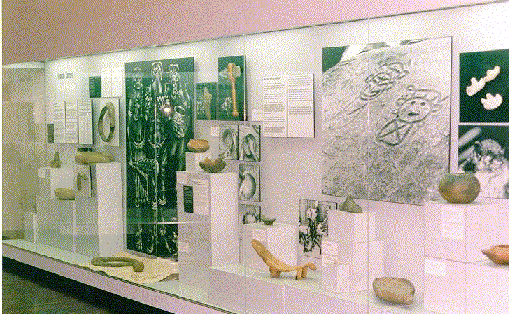
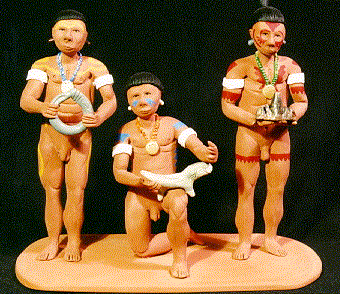
Canoa = canoe
Burén = ceramic grill
Coa = gardening instrument (hoe)
Barbacoa = Bar-B-Que
Tibes = rough stone
Areyto = ceremonial dance
Guasábara = war or fight
Bija = a red pigment
Higüera = a tree whose fruit (the gourds) are used for utensils
Jicotea = water turtle
Anón = fruit tree
Guanábana = fruit
Quenepa = fruit
Guayacán = a tree with very hard wood
Following is a series of Indian scenes. They are representative of the work and activities in the Taino’s daily lives.
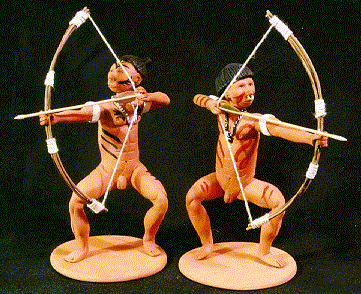
The Tainos were skilled with the bow and arrow which they used to hunt and in war.
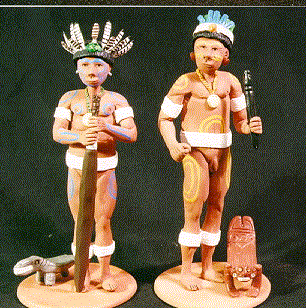
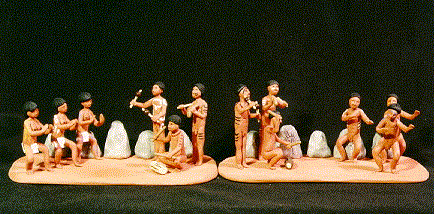 Areyto: The areytos or ceremonial dances were held in the ball fields or ceremonial plazas. They were many types of areytos which were held for a variety of reasons.
Areyto: The areytos or ceremonial dances were held in the ball fields or ceremonial plazas. They were many types of areytos which were held for a variety of reasons. 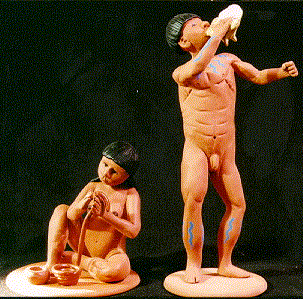 On the left: A Taina making a clay bowl. On the right, a Taino playing a «fotuto» or «guano,» a wind instrument made from a sea shell.
On the left: A Taina making a clay bowl. On the right, a Taino playing a «fotuto» or «guano,» a wind instrument made from a sea shell.
The chiefs were the leaders of the villages (yucayeques). From left to right: A chief with a stone collar, which showed a taíno art form believed to have a religious significance. While we are not sure of its exact meaning, we believe that it represented a God or spirit. A chief seated on a stone stool, a ceremonial seat used principally by the Chief or other important person in the village. A chief with a «cemí,» the physical representation of a spirit or God, summoned through the cemí.
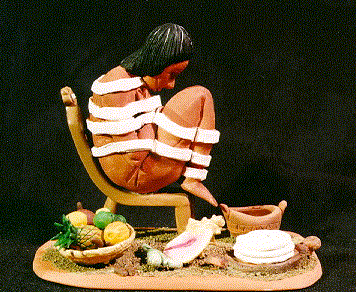
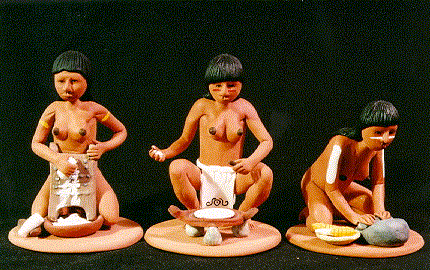
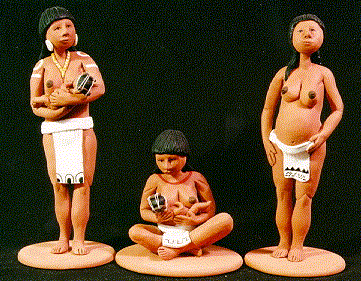
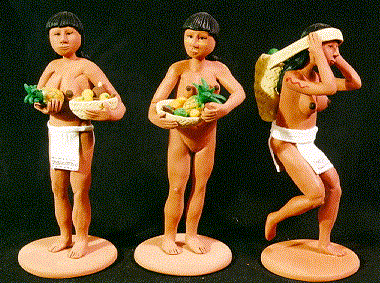
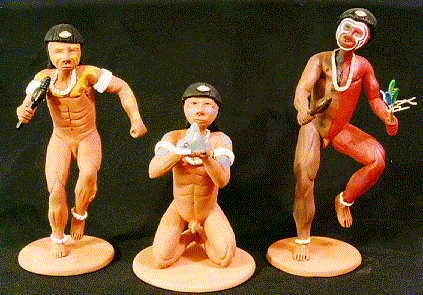
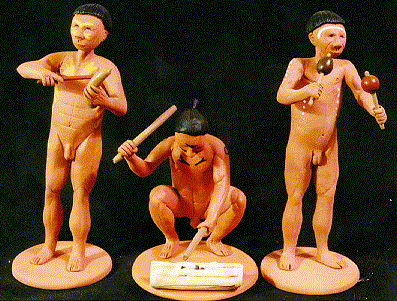
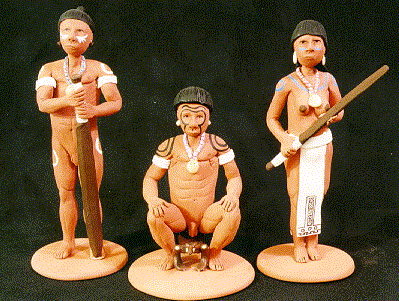
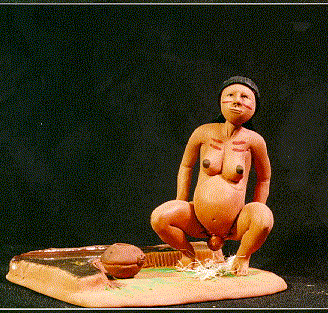
Taina women gave birth squatting and alone. They tried to give birth near a river so that they could bath themselves and their newborn.
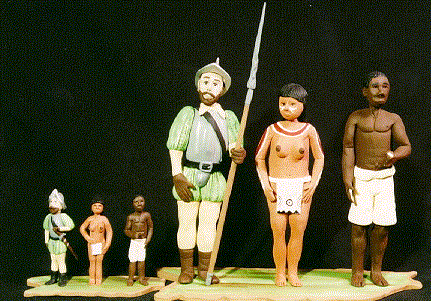
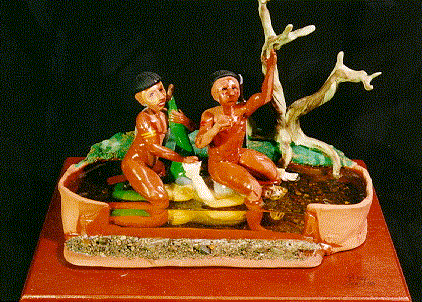
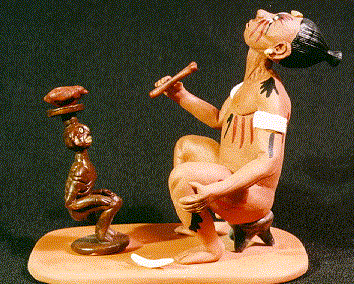
The Tainos had a magical-religious ceremony in which they consulted with a cemi or with the principal God, Yocaju (Yocaju bagua maracote.) On the left is the idol or cemi of the cohoba in the form of Yocaju as the God of Fire. The Tainos put cohoba powder, a potent hallucinogen which was sniffed from the flat surface. in either its pure form or mixed with tobacco or lime. At the right, a Medicine Man inhaling cohoba.
Archaeological Foundation, Inc.
Ponce, Puerto Rico
Following is a report prepared by Frank Hole, Ph.D. a professor in the Department of Anthropology at Yale University, following a three day visit to Tibes in December 1993:
I was struck by the excellent facilities and the beautifully maintained park, with its archaeological and botanical displays. I think the inclusion of the garden with prehistoric cultivars was particularly good (although it had been harvested by the time I left). Anyway, the educational potential for this kind of tie-in is exceptional. I like the reconstruction of the Indian village and would only suggest that one of the huts might be equipped with typical household goods, including pots, mortar and pestle, hammocks, etc. Such a hut would have to be «closed», but it would be effective. Alternatively such a hut might be placed inside the museum.I would recommend some signs explaining the bateyes and other site features. I realize that visitors are supposed to travel with a guide, but this is quite limiting and the practice might be modified for those who wish to explore on their own. I was glad to see that schools groups regularly visit the site.
Now to turn to archaeology. Tibes is a remarkable site whose full value remains yet to be discovered: its potential is hard to judge accurately from what has been recovered so far, but it would seem to be very great indeed. I base this assessment on the following considerations.
- Previous archaeological work has been very limited, despite the uncovering and «restoration» of many of the stone alignments.
- Much of the site has yet to be explored and a number of other stone alignments are known to exist outside the mowed area.
- Except in the burial area, previous excavations have been confined to test pits rather than more extensive, areal exposures.
- Previous work has been largely on the bateyes rather than the spaces between where ethnohistoric sources suggest houses may have stood. Careful excavation in these places may reveal post holes and hut foundations, as well as refuse disposal areas.
- The pottery at the site spans nearly the entire ceramic history of Puerto Rico and it would be surprising not to find some evidence of Archaic peoples at Tibes also. No other similar site has such a long sequence of material.
- The ballcourts are the oldest yet discovered and may show some development and change over the long span of occupation.
- The volume of ceramic and other artifactual material already recovered, as well as potentially recoverable, far exceeds that from any other known site and affords an unusual opportunity for detailed analyses of changes related to time as well as to local styles.
- The skeletal remains constitute an extremely valuable time-series that may reveal changes in diet, nutrition, and race. The principal problems with the extant collection are the lack of relative dating (at least I did not pick up on how the skeletons might be dated, other than through radiocarbon), and their possibly fragmentary condition. Since there is good reason to expect that far more skeletons might be recovered, they should not be removed from the ground unless there is an expert in skeletal analysis on site to effect or direct the actual excavation.
- It is imperative to produce an accurate map of the entire site, probably extending to the surrounding hillsides, and to accurately plot the location of previous excavations, the cemeteries, and stone alignments.
- If we assume that the bateyes were not all used simultaneously, it follows that one should thoroughly investigate the structures in relation to what is beneath them, as well as the surrounding land where there may have been houses or other structures. In this way it may be possible to build up a temporal sequence of structures.
- The possibility that the earth may have been substantially modified should be investigated. For example, batey I lies in a hollow flanked by «shoulders» (or terraces/platforms) on the northernmost of which is batey 4. Another batey may lie to the south but has not been exposed as such. Luis said that the hollow area may once have been a river channel, but I would also suggest that it may have resulted from the building up of the terraces on either side. This could be investigated rather simply by digging a trench from the hollow into each of the banks.
- An accurate and detailed topographic map may reveal other features that suggest artificial terracing, as I suggested above.
Future Activities
- Since Tibes is one of the most important sites in the Caribbean, participation in the planning and further exploration should include a broad spectrum of archaeologists currently working in Puerto Rico. At the same time it should be clear that research must be centrally directed and coordinated by the archaeologists affiliated with Tibes itself. I would suggest that an advisory committee be established to review plans drawn up by the resident archaeologists and to advise on approaches, techniques, personnel, scheduling, sources of financial support and so on.Although the site is large and potentially could support a series of separate archaeological investigations, I would recommend against carving the site into small fiefdoms parcelled out to individual archaeologists. Although such an approach might work, it tends to work against close collaboration and to diffuse authority, lead to variable quality of excavations, and confuse responsibility for analysis and publication. Instead, I would prefer to see some well-defined projects identified and interested individuals could participate in whichever phases of the work they were interested in and competent to deal with. The ability for coordinating these efforts would fall to one person, but the resulting publications would list all contributors. Such a practice would probably ensure that there would be volunteers who have neither the time nor inclination to take on entire projects, but would be happy to participate in a group effort, according to their interests and abilities.From our latest phone conversation it appears that progress in developing a collaborative network has already been made and that a protocol for sorting the pottery, will soon be in hand. I think it is an excellent plan to involve local students. The work will go quickly and give a good basis for further research.I mentioned that there may be some possibilities for having Puerto Rican students come to New Haven as museum interns, working with the very extensive Caribbean collections here. I don’t know how we can implement this, but it seems a very good idea and I will continue to pursue possibilities here.It is not clear to me what formal training in field techniques students in PR have had, but it might be possible to set up a kind of «field school» at Tibes. One way to do this (and not the only way) is to set up a kind of Earthwatch project. Non-PR paying participants would pay the bills and local students could participate without cost. I have not dealt with Earthwatch myself, but many archaeologists have and a lot of work is done that way that could not be afforded otherwise. If there is interest I would be willing to help organize and perhaps participate in such a venture.Another way to do a field school is, of course, under the auspices of an academic institution. A field school director, who might be given a visiting appointment, could actually offer the course is locals are not available. In such a case normal tuition with some college or governmental subvention might cover the expenses.
Since its discovery in 1975, the Tibes Indigenous Ceremonial Park in Ponce has been engaged in a three phase development plan.
Phase I
From 1975 until 1982, was dedicated to site exploration, excavation and restoration. Forty-five acres wore explored; sample excavations were conducted over thirty-two acres; and nine structures wore restored. In addition, skeletal remains and other archeological material were collected.
Phase II
Will provide for the analysis, evaluation, cataloging and interpretation of this material. It will consist of specific areas of investigation, directed at answering the following questions (theoretical framework) by level:1. Inventory and preparation of existing materials, on and off-site2. Study by specialty
A. Human Osteological Remains
1. What were the burial locations, orientations, positions and what information can be gathered from non-osteological burial evidence?
2. What is the demographic pattern: sex, age, stature and racial characteristics?
3. What were the possible causes of death: traumas, illness, natural death; what health effects can be determined; what injuries are noted?
4. What are the DNA characteristics?
5. What information is provided by bone analysis: contaminants. minerals, etc.?
6. What interpretations are suggested by the grave groups (rituals, social status, etc.) and how does it compare with intro and inter sites (Caribbean context)?
B. Vertebrate Remains
1. What vertebrate remains were found and in what proportion?
2. What evidence of raising or maintaining vertebrates (domestication of animals) was found?
3. What vertebrates were consumed; how were they prepared (cooked); what was their percent of consumption?
4. To what area was this fauna indigenous: marine, terrestrial, geographic location?
5.How does its frequency of use suggest habitat exploitation?
6.How were bones used: tools, ornamentation, religious motives, other?
7. Which still exist; which are extinct?
C. Invertebrate Remains
1. What invertebrate remains were found and in what proportion?
2. What invertebrates were consumed; how wore they prepared (cooked); what was their percent of consumption?
3. To what area was this fauna indigenous: marine, terrestrial, geographic location?
4. How does its frequency of use suggest habitat exploitation?
5.How were shells used: tools, ornamentation, religious motives, other?
6. Which still exist; which are extinct?
D. Soil Phytoliths
1. What Phytoliths are present?
2. What are the botanical macro-remains?
3. What plant species existed; how were they used?
4. What pro-historic environmental conditions are suggested by these botanical macro-remains?
E. Lithic Materials (stone)
1. What type of stone was found? In what proportion?
2. What is its source?
3. How does that compare with the stone in the adjoining river? In the river’s source? There may be insufficient samples for evaluation at this time?
4. What technological processes were involved in the manufacture of the artifacts?
5. How was it used: tools, ornamentation, religious motives, construction, other?
F. Geology
1. What was the area’s land configuration and material make-up?
2. What effect did the river have on the environment?
3. What was the effect of human activity on the environment?
G. Ceramic Remains
1. What ceramic styles were found and how can they be defined?
2. What manufacturing technology was used and what are the materials’ characteristics?
3. What are the decorative characteristics: daily use, special use?
4. What are the morphological characteristics (form and function)?
H. Food Remains
1. What does the vertebrate, invertebrate and residual analysis suggest in a macro analysis of food consumption?
2. What habitat exploitation is suggested by this consumption?
I. Drawings and Sketches
1. What are the forms and styles found by the investigators?
J. Photography
1. What is the general topography of the site?
2. What physical evidence was found by the investigators?
K. Conclusion
1. What time periods are represented by the samples?
2. What was the site topography during each of these periods?
3. What can be determined about the inhabitants during each period?
- Demographics
- Style/quality of life
- Social/political indicators
- Settlement patterns
- Communication/commerce
- Environmental zones
- Order of habitation
- The economy
4. What was the function of Tibes during each period?
Procedures
Participating scientists have two roles: to complete their portion of the investigation; and to share their expertise, techniques and findings with Island scientists and students, thus furthering Tibe’s educational mission.
1. Analysis
2. Workshop for Island Scientists explaining procedures and initial findings
3. Final evaluation and report
4. Workshop for Island Scientists joining all parts of the study Anticipated time to complete the evaluation is two years, depending on availability of funding and participating experts.
Dissemination
Findings will be reported in a professional publication made available to libraries, archeologists and interested parties at minimal or no cost.
- Editor – Luis A Rodriguez Gracia
- Preface
- Introduction- Principal Investigator
- Chapters – Task archeologists/investigators/ technicians
- Conclusion – Principal Investigator
It is estimated that the total cost of publication of 2,000 copies will be $10,000.
Phase III
Of the development will be determined following the completion of Phase II. There are a variety of options that may be considered either separately or in some combination:
- Expanding the immediate area of excavation
- Excavating to a greater depth
- Analysis of contiguous areas in Tibes and beyond
By: Nelsonrafael CollazoThe Indian Ceremonial Center of Tibes, located in the city of Ponce was discovered in 1975. The first inhabitants of the area were presumably the Igneris Indians who came from South America. They must have settled here at about the beginning of the Christian era, near the third century. Slowly, the Taíno Indians occupied and shared the places acquired by the Igneris.The Taínos, at approximately 800 years before the Discovery of Puerto Rico, had constructed the «bateyes» or Ceremonial Parks, that we have today at the Tibes Ceremonial Park. Here they used to celebrate their «Areytos» or traditional festivities, their sports and other important events. Maybe in the past, they utilized the place as a cemetery or burial place.There is evidence that they constructed structures (bohíos) in the Ceremonial Center although their living quarters were not built there.At the Museum in the Ceremonial Park of Tibes, we may see burials, charms, idols, vessels, petroglyphs and other artifacts used by the Taíno and Igneris Indians who lived here. The place is a sanctuary of prehistoric trees such as «higüero, hacar, guanábana, corazón» among others. There are varieties of birds such as «martinete (hammer), ruiseñor (nightingale), pitirre, múcaro (owl), zorzal y carpintero (woodpecker), which existed at the times of our Indians. There is also yucca, tobacco, corn, «lerenes» and other indigenous plantations in the area.In this publication we offer beautiful illustrations by two well known Puerto Rican artists: Elpidio Collazo and Angel Jiménez Alfínez. These illustrations will give the reader a clear idea of the people who lived in the Tibes’ Valley in Ponce. The reader will see the clay vessels made by the Indians, places for sports and ceremonies, their homes, celebrations, religious customs, trades, transportation means, arms, domestic utensils, musical instruments, religious or magic representations, trees, fruits and animals.This educational, easy to read book, is intended for the enjoyment of adults as well as children.

Indian Batey

Ceremonial Dances or Celebrations

Burial

Canoe
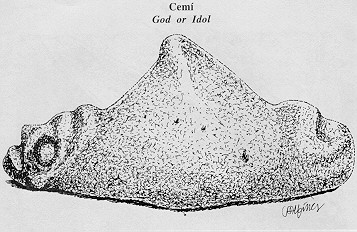
God or Idol

Hammock – a kind of suspended bed

Musical Instrument

Shell Trumpet

Petroglyph – Ponce

Petroglyph – Utuado

Corn

Custard Apple Tree – Annona

Puerto Rican Parrot
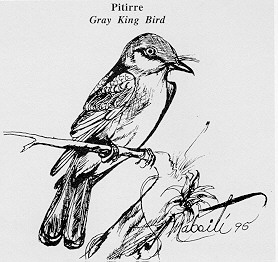
Gray King Bird

Igneri Vessel in Tibes

Indian Bohio (house)

Ball Game

Hunting

Wooden Weapon

Indian Seat

Stone Collar

Musical Instrument

Indian Drum

Petroglyph – Añasco

Petroglyph – Jayuya

Pineapple

Higuera

Puerto Rican Woodpecker

Puerto Rican Lizard Cockoo
